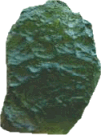
 |
In focus: Moldavite |
| Chemical Composition: Glass | |
| Group: Tektite | |
| Colour: Green | |
| Streak: | |
| Hardness: 5 | |
| Density: 2.2-3.0 | |
| Luster: Vitreous | |
| Cleavage: |
|
Basically, Moldavite is a form of natural glass which resembles obsidian. However, obsidian is of volcanic origin, while Moldavite was created by a meteorite impact, which puts it into a class of rocks known as Tektites (see below). Moldavites are a translucent olive-green and beautiful enought to be considered as gemstones. Richly colored Moldavite is rare, perhaps even rarer than diamonds, rubies or emeralds. Moldovite was named by A. Dufrnoy after Moldauthein in Bohemia, where it occurs. |
One of the characteristic features of Moldavite is the presence of wrinkles on its surface which are similar to the markings on many meteorites. However, the chemical composition of Moldavite resembles that of the Earth's crust rather than that of a meteorite. The latest theory is that as a meteorite hits the earth the pressure and the heat of the impact melts the rocks underneath which are then displaced and actually catapulted into the atmosphere. There they cool down as they fall back down to earth. This theory would explain both the chemical compositionof Moldavite (being of terrestial origin) and surface markings (as Moldovite was formed in the same way as meteorites) .
Moldavites are found in a strewnfield (an area over which a meteorite has fallen) centered around the the Moldau Valley of southern Bohemia, in the Czech Republic and are believed to have come from a huge meteorite impact of about 20 million years ago. The Moldavite strewnfield is divided into two parts and the tektites from each of these parts are recognizeably different in colour. The Moldavite strewnfield is quite small by comparison to some other strewnfields, but none the less great amounts of Moldavite have been found. The most prized are the deeply grooved and clear green pieces.
Tektite is a general term used for pieces of natural glass which originate from meteorite impact (the "Meteorite Impact Theory"). Tektites occur in broad bands, or strewnfields, in specific localities in different parts of the world. Tektites are distributed more or less randomly within the strewnfield. There are four well- established strewnfields on the Earth and some other locations where tektite glass or very similar glass is found. The strewnfields are the North American, The Moldavite, (which is can also be considered as two small strewnfields close to each other), The Ivory Coast, and The Australasian.
Notably, Moldavites (especially the priced pieces) have been marketed under fanciful, misleading misnomers such as Bohemian chrysolite, false chrysolite, pseudochrysolite or water chrysolite, (Chrysolite is a name long applied to Olivine, a gemstone also known by its French name of Peridot.)
| _______________________________ | ||||
| Home | | | Shopping | | | Database |
© Biscuit Software 2004-2015
All rights reserved